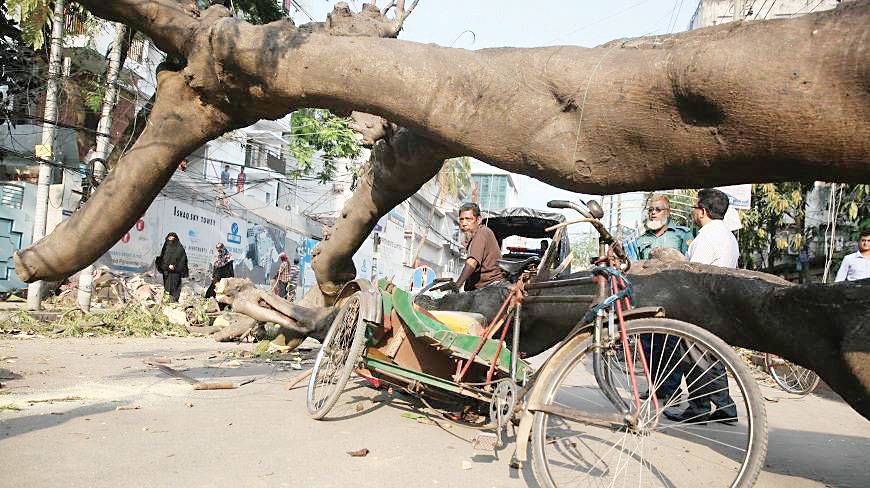Khalid Mahmood Mithu, a well-known artist, script-writer, video editor, and national award-winning cinematographer, died in a tragic incident on March 7 in Dhanmondi when a very large tree fell on him.
The tree also fell on his rickshaw-puller, Abdul Jalil. The tree was uprooted because of soil piled around its trunks, which had slackened in the heavy rain which had fallen the day before the incident.
Nevertheless, most of our news media reported the incident as an accident, whereas the incident was not an accident at all. Rather, this was the result of negligence on part of local authorities, Dhaka South City Corporation in particular.
Although it is very common in Dhaka and almost all over the country to find uncovered manholes, pipes, random fallen billboards, trees, and other generic destruction of life, and property, there exist elected local governments as well as the law to prevent nuisances of this kind.
Hence, an aggrieved person is not only entitled to bring legal action against the local government authority for non-conformity of its duty, he is also entitled to get damages from that body.
However, according to clause 24.9 of the schedule of the Local Government (city corporation) Act 2009, the DSCC has a legal obligation to remove hazardous trees from the road side. From the incident of Mithu, it is evident that the DSCC has completely failed to perform its statutory duty.
When services are provided to members of the public such as maintaining a highway, the public authority owes a duty of care to the public. A failure to take such care can result in the defendant being liable to pay damages to a party who is injured, or suffers loss as a result of their breach of duty of care.
The principle first emerged from the pen of Lord Atkinson in Donoghue v Stevenson (1932) AC 562 case, where he declared that the concerned must take reasonable care to avoid acts or omissions which they can reasonably foresee would be likely to injure the persons who are so closely and directly affected by their act. Subsequently, the concept of duty of care was further developed by the House of Lords in Caparo Industries plc v Dickman (1990) where the court put three questions to determine the liability.
Firstly, was the risk of injury or harm reasonably foreseeable? In the present case, the answer is yes. It is apparent that the DSCC has ignored its duty to do something about the dangerous tree, which foreseeably could have caused damage to the person or the property of the inhabitants of the city.
The tree was deracinated due to heavy rainfall the previous afternoon and the incident took place the next day at about 2pm. That means, they had sufficient time to take the tree away. Furthermore, it seems that there was no intervening cause for the said death. DSCC’s failure to perform its lawful duty is primarily responsible for this unexpected death.
Secondly, was there sufficient proximity between the parties? There may be situations where the risk of personal injury could be foreseen, but it would not be appropriate to make the defendant liable. “Proximity” in this context means not physical closeness, but any form of relationship between the parties.
The question is whether the claimant was a member of the group to which a duty of care was owed. Mithu was not an alien to the city, rather a talented film-maker who had received the National Film Award as best director for his debut film Gohine Shobdo in 2010, and a permanent resident of the locality to whom the city corporation owes full duty.
Finally, is it fair, just, and reasonable, on the ground of public policy, to impose a duty of care upon the corporation? If it would not be fair, just, and reasonable, then what would be exact?
We have already lost a potential life and another person, the rickshaw-puller, was injured. The matter of regret is that we love to ignore many matters which ultimately bring severe consequences for us.
Most people are not aware of the fact that the city corporation has some duties towards its residents, and negligence of those duties may bring on legal action. Indeed, we have very limited application of tort law in this country. Despite that, an aggrieved person can initiate legal action for negligence of legal duty of a local authority.
Interestingly, the act does not suggest any punishment for negligence of any of its legal duties. However, there is only one provision in section 106 which states that, if any employee of the corporation is unable to perform his/her duty, then the government will direct him/her by written order to do his/her function within a specified time. This provision is not at all sufficient, and cannot make the body accountable.
There must be some arrangement of sanction and compensation for non-compliance of its legal duties. Nevertheless, very recently, the High Court Division asked the government to compensate the family of a four-year-old child, Jihad, who had died after falling into a 600-foot deep abandoned, uncovered tube-well pipe at Shahjahanpur in Dhaka on December 26, 2014.
Now, in the absence of any penal or compensatory stipulation, our judiciary can play a vital role to uphold the rights of the citizen and to build these bodies to be more pro-people.
City-dwellers are continuously paying taxes to the local government for the development of their beloved city and to get services from the authority. Additionally, Sec 109 of the mentioned act makes the mayor and counsellors public servants.
Hence, it is the solemn duty of the people’s representatives to do their jobs with due diligence and ensure safety and security of their remuneration providers.
Source: Dhaka Tribune










